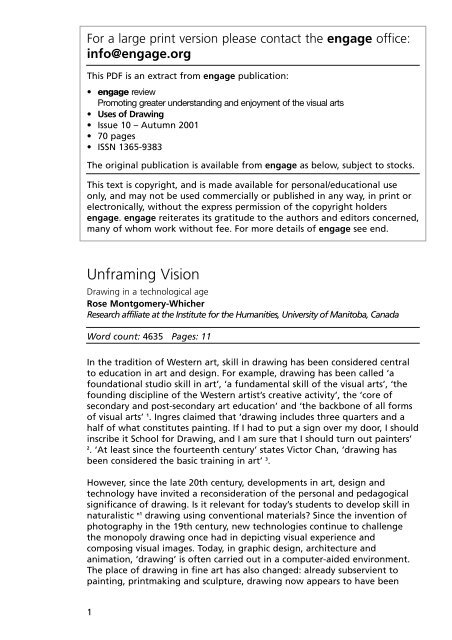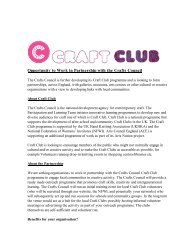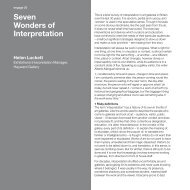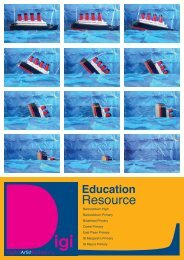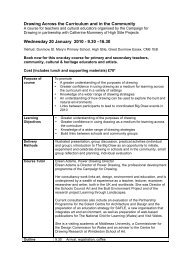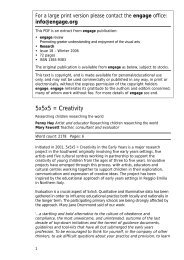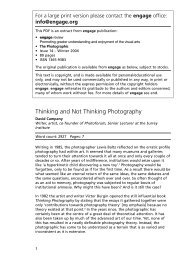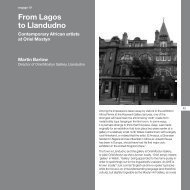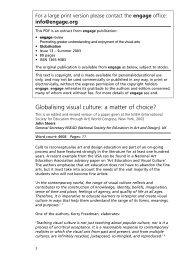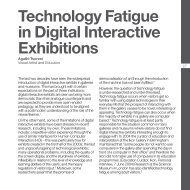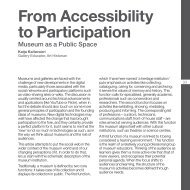10. Rose Montgomery-Whicher - Engage
10. Rose Montgomery-Whicher - Engage
10. Rose Montgomery-Whicher - Engage
You also want an ePaper? Increase the reach of your titles
YUMPU automatically turns print PDFs into web optimized ePapers that Google loves.
For a large print version please contact the engage office:<br />
info@engage.org<br />
This PDF is an extract from engage publication:<br />
• engage review<br />
Promoting greater understanding and enjoyment of the visual arts<br />
• Uses of Drawing<br />
• Issue 10 – Autumn 2001<br />
• 70 pages<br />
• ISSN 1365-9383<br />
The original publication is available from engage as below, subject to stocks.<br />
This text is copyright, and is made available for personal/educational use<br />
only, and may not be used commercially or published in any way, in print or<br />
electronically, without the express permission of the copyright holders<br />
engage. engage reiterates its gratitude to the authors and editors concerned,<br />
many of whom work without fee. For more details of engage see end.<br />
Unframing Vision<br />
Drawing in a technological age<br />
<strong>Rose</strong> <strong>Montgomery</strong>-<strong>Whicher</strong><br />
Research affiliate at the Institute for the Humanities, University of Manitoba, Canada<br />
Word count: 4635 Pages: 11<br />
In the tradition of Western art, skill in drawing has been considered central<br />
to education in art and design. For example, drawing has been called ‘a<br />
foundational studio skill in art’, ‘a fundamental skill of the visual arts’, ‘the<br />
founding discipline of the Western artist’s creative activity’, the ‘core of<br />
secondary and post-secondary art education’ and ‘the backbone of all forms<br />
of visual arts’ 1 . Ingres claimed that ‘drawing includes three quarters and a<br />
half of what constitutes painting. If I had to put a sign over my door, I should<br />
inscribe it School for Drawing, and I am sure that I should turn out painters’<br />
2<br />
. ‘At least since the fourteenth century’ states Victor Chan, ‘drawing has<br />
been considered the basic training in art’ 3 .<br />
However, since the late 20th century, developments in art, design and<br />
technology have invited a reconsideration of the personal and pedagogical<br />
significance of drawing. Is it relevant for today’s students to develop skill in<br />
naturalistic n1 drawing using conventional materials? Since the invention of<br />
photography in the 19th century, new technologies continue to challenge<br />
the monopoly drawing once had in depicting visual experience and<br />
composing visual images. Today, in graphic design, architecture and<br />
animation, ‘drawing’ is often carried out in a computer-aided environment.<br />
The place of drawing in fine art has also changed: already subservient to<br />
painting, printmaking and sculpture, drawing now appears to have been<br />
1
marginalized by new image-making technologies, particularly digital<br />
technologies, and by increasing use of non-traditional media. These<br />
developments call into question the once close relation between art, design,<br />
and drawing. Practitioners, philosophers, art historians, curators and<br />
educators are compelled to ask whether conventional practices of drawing<br />
are threatened by new technologies, and perhaps more importantly, whether<br />
the demise of these practices may imply a loss of particular ways of thinking,<br />
of seeing, and of being in relation to the world and to others.<br />
In this article, I want to examine the strength of drawing as a marginal<br />
practice, suggesting that the enduring significance of drawing (and by<br />
implication its significance in art and design education) is to be found in the<br />
ways in which it differs from dominant practices and media in contemporary<br />
culture. Surrounded by modes of communication and image-making which<br />
are fast, virtual, and relatively easy, drawing seems a remarkably slow,<br />
cumbersome, and difficult way to make a visual image; mastery requires<br />
effort, skill, focused attention and much practice.<br />
In the following, I introduce conceptions of ‘practice’ originated by three<br />
contemporary scholars, Herbert and Stuart Dreyfus, and Albert Borgmann,<br />
whose thinking about the impact of technology has been influenced by the<br />
work of the late Martin Heidegger. These ways of thinking about practice<br />
illuminate questions of skill, work and pleasure, and provide a means of<br />
reconsidering the personal and pedagogical significance of drawing in a<br />
technological age. But first I want to consider ‘practice’ in drawing,<br />
contrasting drawing to practice with a more inclusive notion of drawing<br />
as a practice.<br />
Reflections on practice<br />
In reference to the arts, the word ‘practice’ usually refers to ‘those<br />
repeatable patterns of thought and behavior considered essential to the<br />
development of various artistic skills’ 4 . This conception of practice goes hand<br />
in hand with the saying ‘practice makes perfect’. Practice conceived as to<br />
practice is a means to an end. The end is mastery. Accordingly, a reasonable<br />
degree of competence in drawing, if not mastery, is attainable by those who<br />
are willing to practice.<br />
Peter London 5 reminds art students that the ability to draw like Degas or<br />
Rembrandt is as ‘simple’ as practicing for ten hours a day, six days a week,<br />
for forty years. The point of course is that devoting that much time to<br />
disciplined drawing practice is not so simple! Yet, the statement is<br />
provocative, for it implies that practice, rather than talent, may be the crucial<br />
factor in determining artistic success. In contrast to the popular belief that<br />
drawing is a mysterious ability accessible to only the talented few for whom<br />
it is relatively effortless, an emphasis on practice conceives of drawing as a<br />
teachable skill, making drawing accessible to all, if they are willing to work<br />
at it. Numerous artists and art educators support this view of practice. David<br />
Hockney, for example, claims ‘that anybody can learn to draw quite well just<br />
as anybody can be taught to write’ 6 . Betty Edwards’ and Kimon Nicolaides’<br />
approaches to teaching drawing are based on this belief, and both advocate the<br />
practice of drawing exercises which enable students to develop skills of ‘seeing’ 7,8 .<br />
2
While an understanding of practice as to practice serves as a necessary<br />
reminder of the work involved in learning to draw, it does not explain other<br />
meaningful dimensions of practitioners’ experience. The word ‘practice’ is<br />
also used to refer to a practice, a life activity, which in its fullest sense is a<br />
way of living, a way of doing and being which one continues to learn over<br />
the course of a lifetime. As a life activity, practice also implies work, yet in a<br />
different sense, evident in Picasso’s description of his own youthful drawing<br />
practice.<br />
‘For being a bad student I was banished to the ‘calaboose’ - a bare cell with<br />
whitewashed walls and a bench to sit on. I liked it there, because I took<br />
along a sketch pad and drew incessantly. I think I provoked situations so that<br />
professors would punish me. I was isolated and no one bothered me<br />
drawing, drawing, drawing. I could have stayed there forever drawing<br />
without a stop. True, all my life I’ve been in the habit of drawing, but in that<br />
cell it was a special pleasure difficult to explain. It’s not that I wanted to<br />
excel, rather to work - that’s what one must always do’ 9 .<br />
Here Picasso suggests that the wish ‘to work’ constitutes a different<br />
orientation to drawing practice than working to excel, to develop skills.<br />
What makes this account all the more interesting is that by the time he was<br />
a teenager, banished to the ‘calaboose’ Picasso had already mastered the<br />
skills of naturalistic drawing. Still, he took every opportunity to work at<br />
drawing, for ‘that’s what one must always do’. No matter how accomplished<br />
his youthful work appeared to be by conventional standards, he knew that<br />
the expressive potential of his drawing would continue to develop if he<br />
worked at it. Picasso was among the three artists whose childhood drawings<br />
were studied by David Pariser who speculates that the ‘sureness’ with which<br />
Picasso was able to draw as an adult ‘is in part the end result of tireless<br />
practice’ 10 . Rather than working with an end in view, this attitude to<br />
drawing conceives of ‘work’ as ongoing, open-ended, and unending.<br />
There is another reason why Picasso was ‘in the habit of drawing’<br />
throughout his life: the work of drawing is a ‘special pleasure difficult to<br />
explain.’ What was the pleasure that Picasso felt? We can imagine that for<br />
the teenage Picasso, the experience of drawing, alone, in the bare, whitewashed<br />
room, accentuated the quiet attentiveness of drawing, the delight of<br />
watching the image take shape on the paper.<br />
It is not only accomplished artists who speak of the experience of drawing as<br />
pleasurable, fulfilling and necessary for its own sake. A young man who<br />
owns a hairdressing business at which he works full time, devotes as much<br />
time as possible to drawing and painting. This, he said, in a serious tone, is<br />
something he ‘needs’ to do.<br />
‘I need to have that experience! Exactly what it does for me I don’t know. It’s<br />
the activity as much as the result. And when I do, it’s not fun, it’s not<br />
relaxing. It doesn’t feel like a catharsis. It’s not particularly a relief. Of course<br />
there’s a sense of accomplishment if the drawing or painting goes well. But<br />
for me, the actual process is at least as important as the finished work. It’s<br />
difficult to describe. It’s just it has to be done.’<br />
3
A retired professional who has been drawing and painting as a ‘hobby’ for<br />
about forty years, says ‘I have an attitude about this whole thing, that the<br />
end results are incidental. If someone likes them, well, that’s fine. But the<br />
real result is with you: you’ve done it. To me, the important thing is to have<br />
had the experience. And this, I suppose is the reason to do it’. Her words<br />
recall those of Nicolaides: ‘The effort you make is not for one particular<br />
drawing, but for the experience you are having and that will be true even<br />
when you are eighty years old’ 11 .<br />
What Nicolaides, the hobbyist and the hairdresser share with accomplished<br />
artists such as Picasso is an orientation to drawing that conceives of practice<br />
as a life-long activity. This more inclusive conception of practice permits them<br />
to acknowledge a rich layer of lived meaning which lies below the surface of<br />
instrumental orientations to drawing (practice in the service of mastery or<br />
preparation for other works). While each of these people engages in<br />
drawing as a means to an end, such as developing their drawing skills, or<br />
planning the composition of a painting, they think of each act of drawing as<br />
part of a life-long practice, so that, in addition to mastering and maintaining<br />
skills and producing works of art, each experience is meaningful in itself. Or,<br />
more accurately, in addition to their enjoyment of the experience of<br />
drawing, these artists and hobbyists develop skills and produce works of art.<br />
Thus drawing as a practice is a way of thinking about drawing which<br />
seems to be more inclusive than thinking of drawing practice primarily to<br />
practice skills or to do preparatory work for the production of works of art.<br />
For those who engage in drawing as a practice, the means and ends of<br />
drawing merge in the experience of ongoing work.<br />
Drawing as a marginal practice<br />
Herbert and Stuart Dreyfus have coined the term ‘marginal and nonrationalized<br />
practices’ to describe human activities which, although they<br />
cannot be rationalized as contributing to the ends of ‘human efficiency,<br />
productivity, health and welfare’ 12 are nevertheless vitally important human<br />
practices. ‘Marginal and non-rationalized practices’ are aspects of being<br />
human, things which people do spontaneously, rather than on principle.<br />
These include: going for walks, playing with children, mentoring young<br />
people, caring for the sick, for plants and for animals. Some of these<br />
practices have become professional activities, such as teaching or nursing. In<br />
virtue of being professionalized, some non-rationalized practices seem to be<br />
rationalized: one can take courses, earn degrees, and belong to professional<br />
societies. Nevertheless, what is at the heart of the professions of teaching or<br />
nursing is a non-rationalized impulse to mentor young people or to care for<br />
the sick. Similarly, while drawing is ‘rationalized’ in courses, societies, and the<br />
curricula of secondary and post-secondary education, the impulse to draw<br />
resists rationalization, and cannot be controlled, managed, or technologized.<br />
Thus, drawing from observation is another practice that could be described<br />
as a ‘marginal and non-rationalized practice’. To say that drawing from<br />
observation is a ‘marginal’ practice is not to say that it is ‘trivial and<br />
insignificant’ 13 , but that its significance lies in a different domain from<br />
activities directed towards productivity and efficiency. Drawing is humble,<br />
modest, marginal. Consider the following instances:<br />
4
The snow has finally melted in this Canadian city, and for the first time in<br />
months it is warm and sunny. Children are making chalk drawings and<br />
hopscotches on the sidewalks, colourful counterparts to the crocuses that<br />
have just sprung up in the lawns.<br />
While going for a walk in the welcome coolness of the early morning, a<br />
visitor to south India discovers intricate, geometric mandalas, drawn in<br />
chalk in front of the doorways of some homes and shops.<br />
A boy is drawing with his finger on the bathroom mirror. It’s an<br />
opportunity he just can’t resist: no matter what else is happening, if there<br />
is a steamy mirror, he just has to draw on it.<br />
Two guests are seated side by side at a dinner party in Istanbul; although<br />
neither one speaks a word of the other’s language, they have a lively<br />
conversation through a series of drawings on their table napkins n2 .<br />
A doctor draws a diagram on a scrap of paper to explain to her patient<br />
what is happening inside his body.<br />
A university student spends the afternoon standing, with a sketchbook<br />
balanced on one arm, copying Old Master drawings in an exhibition.<br />
A woman carries a sketch pad on a hike through the mountains. From<br />
time to time, she pauses to draw the landscape, making a series of rapid<br />
sketches to explore possible compositions for a painting. In the same<br />
region, a man sits quietly, making a careful line drawing of a wildflower<br />
for an illustration in a botany book.<br />
The instances of drawing described above show how, in the lives of many<br />
artists, hobbyists, students and children, drawing continues to be a vitally<br />
important activity. In spite of changing trends in the art world, and in spite<br />
of new technologies for image making, people continue to take up and<br />
engage in the practice of drawing, and many artists return to it. Drawing has<br />
an extraordinary resiliency.<br />
Drawing as a focal practice<br />
In addition to the Dreyfuses’ conception of marginal and non-rationalized<br />
practices, there is another, related way of theorizing about life practices.<br />
Borgmann 14 has created the term ‘focal practices’ to identify activities which,<br />
in Herbert Dreyfus’ words, require ‘effort’ and ‘focus’ 15 . The requirement for<br />
effort, focused attention and skill make focal practices a narrower category<br />
of practices than those described by the Dreyfuses; focal practices could be<br />
thought of as belonging to the larger family of marginal and nonrationalized<br />
practices n3 . All forms of drawing could be considered<br />
as marginal and non-rationalized practices, and more specialized, skilled<br />
forms of drawing could be considered as focal practices. For example, while<br />
life drawing could be called a focal practice, doodling, scribbling and some<br />
of the examples cited above - children drawing on the pavement or on<br />
steamy mirrors, a doctor making an explanatory drawing - are marginal and<br />
5
non-rationalized practices. In this way, marginal and non-rationalized<br />
practices are primordial human activities, while focal practices are the skilled,<br />
cultured forms of some of these activities. Borgmann has developed the<br />
notion of focal practices from two sources: the etymology, meanings, and<br />
connotations of the word focus, and Heidegger’s essay on the significance of<br />
‘the thing’ 16 . The word focus can be traced back to Latin where it means<br />
‘hearth’. Borgmann shows how the connotations of ‘hearth’ contribute to<br />
our contemporary understanding of focus. Traditionally, the hearth was ‘a<br />
place that gathered the work and leisure of a family and gave the house a<br />
center’ 17 . Thus, as a ‘thing’ in Heidegger’s sense, the hearth gathered the<br />
elements and its users into a physical and social engagement with it, in its<br />
particular context, and rewarded them spiritually and physically. In current<br />
usage, the word hearth is often metaphorical, referring to the centre of the<br />
home and family life, while we use the word focus (as a noun) to mean a<br />
centre of activity or attention, or (as a verb) to settle on one thing, to<br />
concentrate. In addition to these meanings, focus has a modern optical<br />
meaning as the point at which rays converge and from which they diverge in<br />
a regular manner. This combines with the older meanings of focus to suggest<br />
that a focus is a thing which gathers and centres people and activities, while<br />
illuminating its surroundings 18 .<br />
Even in the midst of contemporary technological culture, there are many<br />
focal things to be found. In addition to Heidegger’s ‘inconspicuously<br />
compliant’ things such as a wine jug, a footbridge, a bench 19 , Borgmann lists<br />
the wilderness, the table, and by implication, the garden 20 . These focal<br />
things however, require focal practices to sustain them: hiking, gardening,<br />
and the making of daily and festive meals. To Borgmann’s list of focal things,<br />
I would add a well-used sketchbook, suggesting that skilled drawing,<br />
particularly when it is undertaken as a life-long practice, is a focal practice.<br />
In drawing, as in other focal practices, the inseparability of means and ends<br />
give rise to meaningful engagement in pleasurable work. People who live<br />
with drawing as a life-long practice describe their experience of drawing as<br />
‘work’ and ‘struggle.’ To describe drawing as work and pleasure, almost in<br />
the same breath, is to describe a particular quality of attention which is<br />
characteristic of ‘focal practices’ in which ‘effort and joy are one; the split<br />
between means and ends, labor and leisure is healed’ 21 . This quality of<br />
attention dwells at the very heart of drawing.<br />
Focal practices allow for the experience of ‘focal reality,’ a way of naming<br />
‘the encounters each of us has with things that of themselves have engaged<br />
mind and body and have centered our lives’ 22 . These kinds of human<br />
experiences seem to be threatened by the way in which technology gives<br />
people easy, quick results - a ready-made meal, a low maintenance garden<br />
with an automated sprinkler system - without requiring an effort, without<br />
focusing attention. And yet, it is against the background of fast-paced<br />
contemporary technological culture that the significance of focal practices<br />
stands out. For example, the focal significance of long distance running out<br />
of doors is highlighted by its contrast to the experience of keeping fit on<br />
machines in a sweaty, windowless gym. Similarly, the focal significance of<br />
patiently drawing landscapes and cityscapes while travelling is readily<br />
apparent when it is contrasted with the fast and inattentive snapping of a<br />
6
disposable camera. Contemporary culture actually serves to highlight what<br />
Borgmann would call the ‘hidden splendor’ of drawing 23 .<br />
Enframing<br />
Heidegger’s essay on technology 24 , originally published in 1954, offers<br />
insights into the ways of thinking which surround rapid technological<br />
development that are still relevant today. He points out that technology<br />
itself is not the problem. Rather, what gives cause for concern is the ‘essence<br />
of modern technology’ which in fact is ‘nothing technological’ but<br />
‘enframing’, a way of regarding everything instrumentally, as being ever<br />
available, convertible and controllable raw materials for efficient and<br />
productive use 25 . Today, raw materials include electronically transmitted text<br />
and digital images, and much of our experience is literally ‘framed’ by the<br />
window of a computer or television screen. Heidegger cautions us against<br />
allowing ourselves to be unthinkingly hurried along by a technological<br />
rationality in which we are increasingly and unthinkingly predisposed to<br />
assume that what is faster, more productive, more expedient, more cost<br />
efficient is necessarily better. The danger, as Heidegger sees it, is that this<br />
increasingly pervasive attitude may consume us and obscure other modes of<br />
revealing the truth of things. He suggests that what will save us from being<br />
taken over by ‘enframing’ is to be found in the ‘realm of art’ which is akin<br />
to, but different from modern technology. The kinship between technology<br />
and art lies in their common ancestry in the Greek word techne. In ancient<br />
Greece, techne referred to both art and craft; art bore ‘the modest name of<br />
techne’; as a way of revealing truth by bringing forth and making present,<br />
techne belonged in the realm of poesis, poetic revealing 26 . For the ancient<br />
Greeks, techne was associated with an understanding of truth as revelation,<br />
rather than a notion of truth as ‘correctness of representation’ 27 . A drawing<br />
which is only a technically accurate representation tends to be dull;<br />
it reveals little about the subject or the maker. Writing in 1846, Baudelaire<br />
sounds contemporary when he describes an ‘exact’ style of drawing as<br />
‘stupid’ and ‘inaccurate by its slavish copying’ 28 . By contrast, an intelligent<br />
drawing has the potential to reveal the truth of embodied vision and<br />
experience. Consider for example, Matisse’s line drawings of the human<br />
figure. Unlike an ‘exact’ representation of a figure in an academic drawing,<br />
these depictions of the human figure reveal much about Matisse, his<br />
relationship to the model and embodied experience.<br />
Un-framing vision<br />
Drawing, according to Edwards, allows for ‘a different, more direct kind of<br />
seeing’ in which we do not just see what we are looking for, and ‘see more<br />
fully and perhaps more realistically’ 29 . While drawing, the focus of our<br />
attention seems to become wider. As we settle down and make the effort to<br />
draw, we begin to see all kinds of visual detail, to see what is in our<br />
peripheral vision. Our vision becomes ‘unframed’: we do not see the subject<br />
as if through a camera’s lens, cut off from its surroundings, nor is our seeing<br />
driven towards productive ends. Seeing ‘more fully’, the world becomes<br />
enlarged: we see more vividly and there is more to see n4 . Frederick Franck<br />
describes some of the ordinary sights near his New York State home that<br />
become visible through drawing: ‘the convoluted network of veins in an oak<br />
leaf, the voluptuous curves of a green pepper, the subtle variations in the<br />
7
forms of five little pears on your table, a bird gathering sprigs of grass to<br />
build its nest, a homeless person across the street, a little girl playing<br />
hopscotch by herself, two old men ambling down a Lower East Side street in<br />
Talmudic discourse’ 30 . Even when we are not drawing, we may continue to<br />
see as if we are drawing. Franck writes, ‘driving my car, or stopping at a<br />
traffic light or a bus stop, in a park, my eye continues to register a face, a<br />
body bending, a pattern of trees swaying in the breeze’ 31 .<br />
Learning to draw requires an immense effort, over a long period of time, to<br />
develop a skill of the body as well as of the mind. In making this effort, we<br />
are compelled to slow down, to focus attention while keeping our peripheral<br />
vision open. With practice, our vision is no longer ‘framed’ by the small<br />
rectangle of a camera’s viewfinder, by the window of a computer screen, or<br />
perhaps most importantly, by a technological rationality in which we see<br />
things only for their usefulness, and we are able to see what unexpected<br />
beauty there is in age, in ruin, in the overlooked and the ordinary. In this<br />
way, drawing fosters an attitude of openness and restores things and persons<br />
to their otherness; as Berger suggests, ‘drawing is a constant question, is a<br />
clumsiness, which is a form of hospitality towards what is being drawn’ 32 .<br />
So is it relevant for today’s students to develop skill in naturalistic drawing<br />
using conventional materials? If our thinking is ‘enframed’ by a technological<br />
rationality, then the slowness, the clumsy, costly, messy materiality of<br />
drawing may compel us to respond that developing skill in naturalistic<br />
drawing, with conventional materials, need not be a priority for today’s<br />
students, whether they are children, adult hobbyists, or young adults who<br />
are aspiring to become artists and designers. If, on the other hand, our<br />
thinking has not fallen prey to a technological rationality, we can respond to<br />
the question of the contemporary pedagogical relevance of drawing<br />
with a ‘yes’.<br />
In the above I have tried to sketch the outlines of an argument to show how<br />
the personal and pedagogical significance of drawing dwells in its practice.<br />
When drawing is considered as a marginal and non-rationalized practice, its<br />
significance as a human activity becomes apparent. As a focal practice,<br />
drawing finds its significance not only in the realms of art and design, and<br />
art and design education, but in the broader arena of life practices which<br />
gather and illuminate our lives through focused attention, effort and skill. In<br />
the context of contemporary culture, drawing is a ‘marginal’ practice which<br />
endures because it differs from dominant practices and media, a practice<br />
which, I believe, still deserves a central place in art and design education.<br />
References<br />
1<br />
Quotes in order of appearance:<br />
Anderson, T. (1992), ‘Drawing upon the eye, the brain and the heart’ Art<br />
Education, 45 (5), p. 45.<br />
Edwards, B. (1999), The new drawing on the right side of the brain, (revised<br />
and expanded edition), New York: Tarcher/Putnam, p. 9.<br />
Dinham, J. (1989), ‘Drawing: What is it and why has it traditionally held a<br />
special place in the art programme?’ Journal of Art and Design Education,<br />
8(3), p. 324.<br />
Hurwitz, A. and Mosely, Q. (1986), ‘Foundation programs: the basics of art<br />
8
education’ School Arts.<br />
85 (9), p. 35.<br />
Rockman, D. (2000), The art of teaching art: a guide to teaching and learning<br />
the foundations of drawing-based art, Oxford: Oxford University Press, p. 6.<br />
2<br />
Ingres, in Chan, V. (1995), Rubens to Picasso: Four centuries of master<br />
drawings, Edmonton, AB: Department of Art and Design, University of<br />
Alberta in collaboration with the University of Alberta Press, p. <strong>10.</strong><br />
3<br />
Ibid., p. <strong>10.</strong><br />
4<br />
Howard, V. (1982), Artistry: The work of artists, Indianapolis: Hackett, p.<br />
157.<br />
5<br />
London, P. (1989), No more second hand art:<br />
Awakening the artist within, Boston: Shambala, p. 16.<br />
6<br />
Hockney, in Camp, J. (1981), Draw: How to master the art (foreword by D.<br />
Hockney), London: Dorling Kindersley, p. 6.<br />
7<br />
Edwards, B. (1999), op. cit.<br />
8<br />
Nicolaides, K. (1941), The natural way to draw, Boston: Houghton Mufflin.<br />
9<br />
Picasso, in Chan, V. (1995), op. cit., p. <strong>10.</strong><br />
10<br />
Pariser, D. (1985). ‘The juvenalia of Klee, Toulouse-Lautrec and Picasso: A<br />
report on the initial stages of research into the development of exceptional<br />
graphic artistry’, in B. Wilson and H. Hoffa (eds.), The history of art education<br />
(pp. 192-202). State College, Pennsylvania: Pennsylvania State University, p.<br />
199.<br />
11<br />
Nicolaides, K. (1941), op. cit., p. 2.<br />
12<br />
Herbert and Stuart Dreyfus in Flyvbjerg, B. (1991), ‘Sustaining nonrationalized<br />
practices: body-mind, power and situational ethics: an interview<br />
with Herbert and Stuart Dreyfus’, Praxis International, 11 (1), p. 98.<br />
13<br />
Herbert Dreyfus, ibid., p. 98.<br />
14<br />
Borgmann, A. (1984), Technology and the character<br />
of contemporary life: a philosophical inquiry. University of Chicago Press and<br />
Borgmann, A. (1992), Crossing<br />
the postmodern divide. Chicago: University of<br />
Chicago Press.<br />
15<br />
Herbert Dreyfus, in Flyvbjerg, B. (1991), op. cit., p. 99.<br />
16<br />
Heidegger, M. (1971). ‘The thing’ (A. Hofstadter,<br />
trans.), in M. Heidegger, Poetry, language, thought<br />
pp. 162-185. New York: Harper & Row, (original work published 1950.<br />
17<br />
Borgmann, A. (1984), op. cit., pp. 41-42.<br />
18<br />
Borgmann, A. (1984), op. cit., p. 197; Borgmann, A. (1992), op. cit., p. 96.<br />
19<br />
Heidegger, M. (1971), op. cit., p. 182.<br />
20<br />
Borgmann, A. (1984), op. cit., p. 197.<br />
21<br />
Borgmann, A. (1984), op. cit., p. 202.<br />
22<br />
Borgmann, A. (1992), op. cit., p. 119.<br />
23<br />
Borgmann, A. (1984), op. cit., p. 196.<br />
24<br />
Heidegger, M. (1977), ‘The question concerning technology’ (W. Lovitt,<br />
trans.), in D. Krell (ed.), Martin Heidegger: Basic writings, San Francisco:<br />
Harper, pp. 287-317, (original work published 1954).<br />
25<br />
Heidegger, M. (1977), op. cit., p. 302.<br />
26<br />
Heidegger, M. (1977), op. cit., pp. 294, 316.<br />
27<br />
Heidegger, M. (1977), op. cit., pp. 294, 295.<br />
28<br />
Baudelaire, in Gayford, M. and Wright, K. (eds.) (1999), The Penguin book<br />
of art writing, London: Penguin Press, p. 411.<br />
9
29<br />
Edwards, B. (1999), op. cit., p. xxv.<br />
30<br />
Franck, F. (1993), Zen seeing, Zen drawing, New York: Bantam, pp. xii, 19,<br />
116.<br />
31<br />
Franck, F. (1993), op. cit., p. 17.<br />
32<br />
Berger, in Gayford, M. and Wright, K. (eds.) (1999), op. cit., p. 421.<br />
Notes<br />
n1<br />
I have chosen to use the term ‘naturalistic’ drawing rather than<br />
‘representational’ or ‘realistic’ drawing; not only because this word carries<br />
less philosophical baggage, but because it seems to suggest a more inclusive<br />
range of observational drawings, from loose sketches to highly finished<br />
studies, drawings which may not be ‘correct’ or objectively ‘true’ but which,<br />
nevertheless, are true to some aspect of the lived experience of seeing.<br />
n2<br />
This is my summary of Berger's experience that he describes in : Berger, J.<br />
(2000) 'To take paper, to draw: A world through lines, in D. Chasman and E.<br />
Chiang (Eds), Drawing us in: how we experience visual art, pp. 118-<br />
124,Boston: Beacon Press, p. 119.<br />
n3<br />
Herbert Dreyfus describes focal practices as a ‘sub-class of marginal<br />
practices’ (in Flyvbjerg, 1991, p. 99).<br />
n4<br />
My thanks to Cynthia Taylor, Professor of Art Education at the Nova Scotia<br />
College of Art and Design, for pointing out to me in November 1996<br />
(in the midst of a spectacular landscape in central Spain), that a significant<br />
difference between using a camera and drawing is in the way in which<br />
looking through a camera frames vision whereas drawing allows for<br />
peripheral vision, a broader view, a more open way of seeing.<br />
––––––––––––––––––––––––––––––––––––––––––––––––––––––––––––––––––––––––<br />
<strong>Rose</strong> <strong>Montgomery</strong>-<strong>Whicher</strong> is currently a research affiliate at the Institute for<br />
the Humanities, at the University of Manitoba, Canada. Following the<br />
completion of her Ph.D. in 1997, she was a lecturer in art and design<br />
education at the Institute of Education, University of London, England. Her<br />
research and publications focus on drawing and the use of<br />
phenomenological and interpretive methodologies in art education research.<br />
montgome@cc.UManitoba.CA<br />
––––––––––––––––––––––––––––––––––––––––––––––––––––––––––––––––––––––––<br />
engage is a registered not-for-profit educational association which promotes<br />
access to and understanding of the visual arts through gallery education and<br />
cultural mediation nationally and internationally.<br />
engage has a membership of over 1000 worldwide, including galleries, arts<br />
centres, museums, artists studios, artists, curators, teachers, students as well<br />
as gallery education and cultural mediation staff and freelancers. engage<br />
works in three key areas: action-research (including the Collect & Share<br />
lifelong learning network in Europe – see www.collectandshare.eu.com),<br />
professional development, advocacy (see www.engage.org).<br />
engage is building an international online case study database, and a resource<br />
and library of relevant reports, evaluations, and research. engage welcomes<br />
offers of material to make available to the sector through these channels.<br />
10
To enquire about copyright, to subscribe to the engage journal or join<br />
engage, or to offer material for the database or website, please email<br />
info@engage.org<br />
engage is grateful to the Arts Councils of England, Scotland and Wales, to<br />
the Depts of Culture and Education in England, to the British Council and the<br />
European Commission, and to the Esmee Fairbairn and Baring Foundations<br />
for ongoing support.<br />
11


